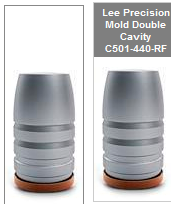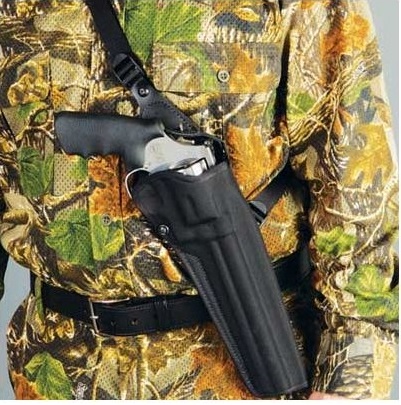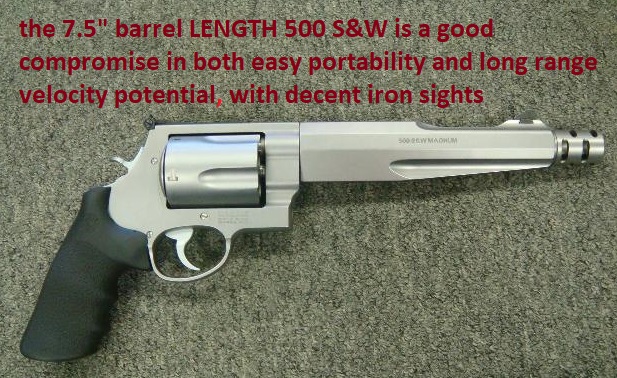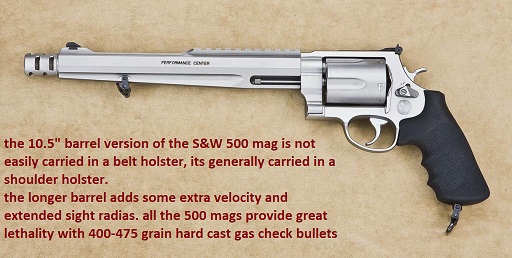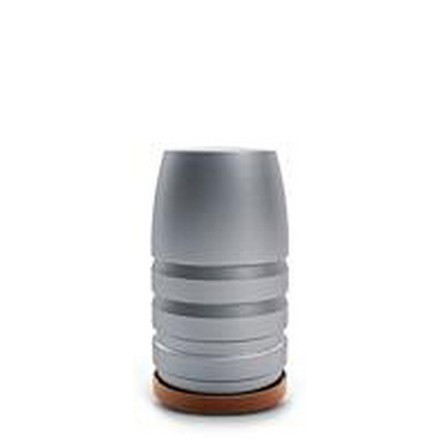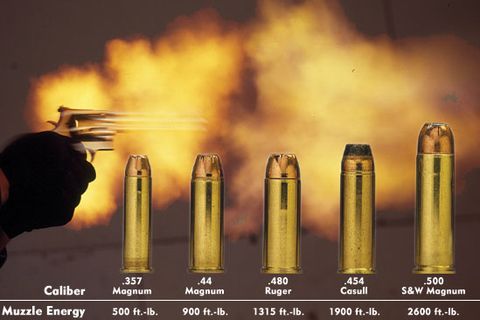Compared: the .460 and .500 S&W Magnums
By Chuck Hawks
In 2004, at the SHOT trade show, Smith and Wesson unveiled their .500 Magnum cartridge in a special, long cylinder/long frame revolver specially designed for the oversized cartridge. This was dubbed the "X-frame" revolver and an 8-3/8" barrel with a muzzle brake was the original configuration.
The new cartridge was ballyhooed as the most powerful revolver cartridge in the world. S&W's intention was to make it impossible for other manufacturers to chamber their existing revolvers for the cartridge, since the cylinders would not be long enough to accommodate the .500 cartridge. In this they were successful, as (to the best of my knowledge at this time) only Taurus has bothered to create a new revolver--a lengthened version of their Raging Bull model--designed for the .500 S&W cartridge.
While largely successful in restricting competition from most other handgun manufacturers, they also severely limited the popularity of the .500 Magnum cartridge, since a selection of guns to shoot it was not available and many shooters prefer not to purchase S&W products. (See
The Dark Side of Smith & Wesson for that story.)
Another problem for S&W was the limited appeal of their new X-frame revolver. Anyone not interested in a .50 caliber revolver was automatically excluded from being a potential Model 500 customer and the very limited market appeal increased the per unit production cost of the gun.
At least a partial solution to that problem appeared at the 2005 SHOT Show, where S&W introduced a .45 caliber version of the X-frame revolver. This fired a new cartridge based on the .454 Casull case lengthened to fit the X-gun's cylinder. Strangely, since they were attempting to appeal to a wider market, they named the new cartridge the .460 Magnum, implying that it is an odd caliber, which it is not.
To this day, many handgun shooters do not realize the .460 S&W shoots standard .45 caliber revolver bullets. The X-frame revolver chambered for the new cartridge became the S&W Model 460 and, like the Model 500, it was introduced with an 8-3/8" barrel with a muzzle brake.
The .460 and .500 are hunting cartridges, pure and simple. Unfortunately, their outsize recoil and muzzle blast keep the vast majority of handgunners from shooting them accurately. Since correct bullet placement, not raw power, is the key to humane, one shot kills of big game animals, the .460 and .500 should be attempted only by the most experienced and recoil tolerant handgun hunters. Even for these individuals, it takes practice to master these cartridges.
The .460 S&W Magnum
Designed by Hornady at the behest of Smith & Wesson for their oversize X-frame revolver, the .460 Magnum actually uses .452" diameter bullets. This is good for reloaders, since many bullets from many bullet makers are available for the .45 Colt and .454 Casull cartridges and the misnamed .460 S&W Magnum can shoot them all. Hornady, Federal, Winchester and Cor-Bon offer factory loaded .460 Magnum ammunition. Depending on the manufacturer, factory loaded bullet weights range from 200 grains to 395 grains.
The .460 Magnum was designed specifically as a handgun hunting cartridge for CXP2 (deer size) and CXP3 (elk size) big game and that is its sole purpose. It has no rational personal defense, pistol match or plinking applications. Factory loaded ammunition is offered in the various manufacturers' hunting ammo lines.
The .460's claim to fame is that it kicks a bit less than the .500 Magnum, making it easier with which to hit. Unfortunately, the muzzle blast is ear splitting, made even worse by the revolver's muzzle brake, which promotes flinching. The .460 kicks appreciably harder than the .454 Casull or .480 Ruger, which are for hunting the same CXP2 and CXP3 game animals.
The .460 uses a straight, rimmed case with a 0.478" outside diameter. It is 1.80" long and the rim diameter is 0.520". The maximum cartridge overall length (COL) is 2.275". A large rifle size primer is used for ignition.
The extraordinarily high SAAMI specified maximum average pressure (MAP) is 65,000 psi, the same as the MAP of the .300 Weatherby Magnum rifle cartridge! However, cartridges load to this pressure are often difficult to extract from a revolver, so the
Speer Reloading Manual #14 recommends holding pressure to no more than 55,000 psi for reliable operation.
The .500 S&W Magnum
The .500 Magnum was designed by Cor-Bon specifically for the S&W X-frame revolver. Until the introduction of the .460 Magnum a year later, the .500 was the only cartridge offered in the X-frame gun.
Like the .460, the .500 is a purpose built, big game hunting cartridge. Hornady, Federal, Winchester and Cor-Bon offer factory loaded .500 Magnum ammunition in their handgun hunting lines. Depending on the manufacturer, factory loaded bullet weights range from 275 grains to 500 grains.
Although the Model 500 X-frame revolver is long, heavy and massive, the recoil of the .500 Magnum cartridge remains punishing. It sounds like a magnum caliber rifle when fired and, even in full daylight, a couple feet of flame visibly jets from the muzzle.
It is kind of interesting to watch a newcomer to the cartridge shoot for the first time. Groups typically look like shotgun buckshot patterns and "grounders" (bullets hitting the ground in front of the target frame) caused by severe flinching are common, even at the relatively short range of 25 yards.
The .500 S&W uses a straight, rimmed case. It measures 0.530" in outside diameter with a 0.560 rim diameter and a length of 1.620". The COL is 2.250" and the bullet diameter is .500". A large rifle primer is used for ignition. The SAAMI specified maximum average pressure (MAP) is 60,000 psi. As with the .460, cartridges loaded to maximum pressure can create extraction problems in revolvers, so most factory ammunition and sensible reloads are intentionally kept somewhat below the MAP for reliable operation.
The Comparison
We will compare the .460 Magnum and the .500 Magnum in velocity, kinetic energy, trajectory, sectional density, bullet cross-sectional area and recoil. Federal Cartridge offers factory loaded ammunition and provides full ballistic information for both cartridges, so we will use Federal loads for comparison.
To represent the .460 Magnum we will use Federal's Premium load with a 300 grain Swift A-Frame bullet at 1750 fps. Full power.500 Magnum ammunition will be represented by Federal's Premium load using a 325 grain Swift A-Frame bullet at 1800 fps. These are typical hunting and field loads for their respective calibers. Federal ballistics for both calibers are taken in 8.4" vented test barrels that simulate 8-3/8" revolver barrels and we will use their figures in this comparison.
Velocity
Velocity is important for initiating bullet expansion and it is the most important factor in calculating kinetic energy. Higher velocity flattens trajectory, making hitting easier at extended ranges and particularly at unknown ranges in the field. Here are the velocities in feet per second (fps) of our comparison loads at the muzzle (MV), 25, 50, 75 and 100 yards.
·
.460 Mag, 300 gr. A-Frame: MV 1750 fps, 1630 fps at 25 yards, 1510 fps at 50 yards, 1400 fps at 75 yards, 1300 fps at 100 yards.
·
.500 Mag, 325 gr. A-Frame: MV 1800 fps, 1680 fps at 25 yards, 1560 fps at 50 yards, 1450 fps at 75 yards, 1350 fps at 100 yards.
As you can see, the .500 load is slightly faster at all ranges, from the muzzle to 100 yards. This bodes well for the .500 in terms of energy and trajectory.
Energy
Kinetic energy is defined as the ability to do work. In this case, the "work" involved is primarily powering bullet penetration and expansion. Both are, of course, necessary for lethality. Here are the energy figures in foot-pounds (ft. lbs.) for our comparison loads from the muzzle (ME) to 100 yards.
·
.460 Mag, 300 gr. A-Frame: ME 2040 ft. lbs, 1760 ft. lbs. at 25 yards, 1510 ft. lbs. at 50 yards, 1300 ft. lbs. at 75 yards, 1125 ft. lbs. at 100 yards.
·
.500 Mag, 325 gr. A-Frame: ME 2340 ft. lbs, 2030 ft. lbs. at 25 yards, 1755 ft. lbs. at 50 yards, 1515 ft. lbs. at 75 yards, 1315 ft. lbs. at 100 yards.
Based on these figures, the .500 Magnum deserves its ferocious reputation. It generates substantially more kinetic energy than the .460 at all ranges. This should translate to superior killing power in the field.
Trajectory
It should be remembered that, in the field, game is not shot right off the muzzle, so a relatively flat trajectory is important to handgun hunters. For field use, I would suggest a 100 yard zero for both of these cartridges, which should mean a mid-range trajectory (maximum bullet rise) of about 2.5-3 inches between the muzzle and 100 yards. This will give a useful range of about 125 yards before a big game hunter needs to consider holding over the designed point of bullet impact.
Federal Cartridge bases their handgun trajectory information on a 25 yard zero and for comparison purposes we will use Federal's trajectory figures. Here are the Federal trajectory figures (in inches) for our selected loads, based on a 25 yard zero from a revolver with iron sights.
·
.460 Mag, 300 gr. A-Frame: +/- 0" at 25 yards, +0.1" at 50 yards, -0.8" at 75 yards, -2.8" at 100 yards.
·
.500 Mag, 325 gr. A-Frame: +/- 0" at 25 yards, +0.1" at 50 yards, -0.6" at 75 yards, -2.4" at 100 yards.
These figures show that, using Federal Premium factory loads, the .500 shoots slightly flatter than the .460 out to 100 yards. The difference, however, is small (only 0.4" at 100 yards) and for big game hunting purposes can be ignored. Note that both of these cartridges shoot flat enough, even with a 25 yard zero, that the big game hunter has no need to hold over for a heart/lung shot at 100 yards, even if the game is a relatively small deer or a pronghorn antelope.
Sectional Density
Sectional Density is the ratio of a bullet's weight (in pounds) to its diameter squared (in inches). SD is important when comparing cartridges and loads because, other factors (such as impact velocity and bullet design) being equal, the bullet with the greatest SD will penetrate deeper, creating a longer wound cavity and increasing tissue destruction. Obviously, however, if the bullet penetrates all the way through the target, wounding ceases.
The actual bullet diameter for the .460 S&W is .452" and the actual bullet diameter for the .500 S&W is .500" Here are the SD's for our selected bullets.
·
.460 Mag, 300 gr. bullet: .210 SD
·
.500 Mag, 325 gr. bullet: .186 SD
As you can see, the 300 grain .45 caliber bullet has a substantial advantage over the 325 grain .50 caliber bullet in sectional density. Since the two A-Frame bullets are of similar construction, we can assume that our comparison .460 load should penetrate deeper than the .500 load.
However, while 300 grains is a heavy bullet for a .45 caliber handgun, 325 grains would be considered a medium weight bullet for a .50 caliber handgun. Among the heaviest bullets offered for the .500 S&W are the Hornady XTP (jacketed hollow point) and Cor-Bon HC (hard cast lead) offerings, both weighing a massive 500 grains. These .50 caliber, 500 grain bullets boast a SD of .286.
Cross-Sectional Area
Other things (such as bullet construction and expansion ratio) being equal, a fatter bullet makes a larger hole and consequently a wider wound cavity with increased area. Note that cross-sectional area is independent of bullet weight. Here are the cross-sectional areas of our .452" and .500" diameter bullets to five decimal places.
·
.460 Mag (.452"): 0.16046 sq. in.
·
.500 Mag (.500"): 0.19635 sq. in.
Obviously, the .50 caliber bullet has an advantage over the .45 caliber bullet in cross-sectional area.
Recoil
Greater recoil is always bad. It makes accurate bullet placement more difficult by increasing flinching and increases the recovery time required between shots. Both of these cartridges deliver fierce recoil, even in massive X-frame revolvers with 8-3/8" barrels. Neither is controllable by the vast majority of handgun shooters and should be avoided for that reason. Here are some approximate recoil energy (ft. lbs.) and velocity (fps) figures for our comparison loads fired in a 4.5 pound revolver (the approximate weight of the S&W Model 500 with an 8-3/8" barrel).
·
.460 Mag, 300 gr. bullet at 1750 fps: 31.52 ft. lbs; 21.24 fps
·
.500 Mag, 325 gr. bullet at 1800 fps: 41.00 ft. lbs; 24.22 fps
These are absurd recoil energy and velocity figures, far beyond the approximately 10 ft. lbs. of recoil energy and 12.5 fps recoil velocity you would expect from a full power .44 Remington Magnum load (240 grain bullet at 1271 fps) fired from a big 4.1 pound revolver. Not many handgunners can do their best shooting with a .44 Magnum hunting revolver and far fewer can control the outsize recoil of a .460 or .500 Magnum revolver. According to these figures, the .460 kicks over three times as hard as a full power .44 Magnum and the .500 kicks over four times are hard as a .44 Magnum. Buyer beware!
Conclusion
The .500 Magnum prevails in the velocity, energy, trajectory and bullet cross-sectional area comparisons with our Federal factory loads. The .460 Magnum wins the sectional density and recoil comparisons. However, the differences between the two cartridges in velocity and trajectory are basically inconsequential.
The difference in recoil is not inconsequential. The .500 generates about 33% more recoil energy than the .460, which is very significant to even the most hardened handgun hunters.
It is fair to say these are truly specialized cartridges, suitable for use only by a tiny minority of experienced handgun hunters. Their thunderous power is generally superfluous, since it is good bullet placement, not raw power, which cleanly harvests big game animals.
(I have to point out that after handloading these cartridges, and watching the results the owners have rather consistently seen,)
that theres zero need to load either the 460 or 500 S&W mag revolvers to their max velocity or pressure levels ,in these revolvers.
and the use of a reasonably heavy gas check cast bullet in either had rather impressive penetration.
longer 6"-10" barrels allow iron sights to be more easily used and the longer bore aids considerably in increasing velocity's
but if you decide on the longest barrel and a scope you might as well buy and use a carbine, in 45/70 or 450 marlin,
as the weight and ease of handling with a carbine makes it a better weapon,
in my opinion
Id suggest a 320-400 grain bullet in a 460 and a 375-500 grain bullet in the 500 mag ,
in both cases theres no real need to exceed about 1500 fps,
as most game is shot well under 120 yards)
in either case the hard cast bullets exit from almost any angle in my experience on deer and hogs and certainly have more than adequate power for elk.
consider a 44 mag with a 310 grain bullet pushed to about 1360 fps,
shoots clear through an elks chest and exits in my experience.
video shows 500 mag hard cast penetration
notice its much better than the expanding copper jacketed projectiles
and if you punch through the vital organs a quick kill is the result,
anything that punches through 64" of ballistic gel will yield impressive results in the hands of a hunter ,
that knows the games anatomy and can consistently hit his intended target area.
you just don,t get nearly this consistent or deep, penetration,
with most smaller caliber expanding bullet designs
500 mag, 45/70 and 450 marlin are all very effective,
with 400 grains or greater in a hard cast projectile.

